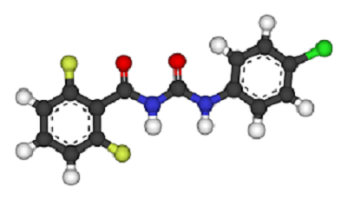Diflubenzuron: Applications in Agriculture and its Cardiotoxicity
General Description
Diflubenzuron (DFB), an insecticide and acaricide insect growth regulator, can be used in agriculture against insect predators and in public health programs, to control insects and vectors, mainly Aedes aegypti larvae.1 Additionally, research has shown that diflubenzuron can induce cardiotoxicity in zebrafish, disrupting cardiac development through oxidative stress, apoptosis, and suppression of essential cardiac genes. These findings highlight the need for careful regulatory assessment to balance efficacy and ecological safety.

Figure 1. Diflubenzuron
Applications in Agriculture
Diflubenzuron (DFB), 1-(4-chlorophenyl)-3-(2,6-difluoro-benzoyl) urea, insecticide and acaricide insect growth regulator (IRC), belonging to the class of benzoylureas, can be used in agriculture, against insect predators, to control fish ectoparasites and in public health programs, to control insects and vectors, mainly Aedes aegypti larvae. This class of insecticides acts by interfering with the deposition of chitin, one of the compounds of the insect cuticle. The toxic mechanisms of these compounds exert their action on immature forms (lar-vae), particularly during ecdysis, preventing the insect to release itself from the exocuticle.
In contrast to its wide use, one of the DFB metabolites (4-chloroaniline) was classified by the United States Environmental Protection Agency (USEPA, 1997) as a probable human carcinogen, which points to the need for toxicological studies. Studies conducted on several fish species indicate that DFB has low toxicity to fish, while others show adverse effects after exposure to the pesticide. However, few toxicological studies have been conducted using rodents as experimental models, and those found in the literature are very old. In one of the studies conducted, rats exposed for 3 weeks (1 h/day, 5 days/week) to technical grade of DFB at concentrations of 0, 0.5, 5.0, or 50 mg/liter/air showed methemoglobin levels in the two lower concentrations, significantly higher than those of the control animals. These results indicate that exposure to DFB can interfere with the homeostasis function in organisms, which reinforces the need for further toxicological evaluation of this compound.
Cardiotoxicity
Impact on Zebrafish Cardiac Development
Recently, zebrafish embryos were selected to evaluate the toxicity of diflubenzuron. The results show that exposure to diflubenzuron leads to the death of embryos, decreases heart beats rate and induces severe pericardial edema, which suggests that diflubenzuron exposure induces cardiac developmental toxicity of zebrafish embryos.
Zebrafish embryo cannot survive a diflubenzuron concentration of 4.5mg/L. Therefore, the lethal concentration 50 (LC50) of diflubenzuron for zebrafish at 96 hpf was analyzed (3.5 mg/L), which is lower than those of other insecticides. For example, LC50 of bifenazate and thiophanate-methyl for zebrafish at 72 hpf was 14.5 mg/L and 50.45 mg/L, respectively. Flupyradifurone is a new butenolide insecticide, and it was found that the LC50 of flupyradifurone to zebrafish embryos at 96 hpf is 210 mg/L. Thus, among these insecticides, diflubenzuron shows a higher toxicity to zebrafish at the same concentration.
Oxidative stress is one of the toxic mechanisms caused by the entry of most external compounds into the organism. It destroys the immune function of the organism, causes damage to cell components and even leads to cell apoptosis in serious cases. Oxidative stress induced by combined exposure of triazophos and imidacloprid to zebrafish embryos may be the basis of the mechanism of the apoptosis effect. AO staining showed that the number of apoptotic cells in heart region increased under diflubenzuron exposure. Moreover, the expression of apoptosis-related genes (bax, p53, caspase3 and caspase9) was also activated. Therefore, we speculate that the developmental toxicity and neurotoxicity induced by diflubenzuron may be caused by ROS-induced apoptosis in the process of proliferation. 2
References:
[1] ALINE LIMA DE BARROS. Subacute toxicity assessment of diflubenzuron, an insect growth regulator, in adult male rats[J]. Environmental Toxicology, 2014, 31 4: 383-504. DOI:10.1002/tox.22054.[2] XUE HAN. Diflubenzuron Induces Cardiotoxicity in Zebrafish Embryos.[J]. International Journal of Molecular Sciences, 2022, 23 19. DOI:10.3390/ijms231911932.
Related articles And Qustion
Lastest Price from Diflubenzuron manufacturers

US $120.00-65.00/kg2025-04-21
- CAS:
- 35367-38-5
- Min. Order:
- 1kg
- Purity:
- 97%
- Supply Ability:
- 20MT

US $10.00/KG2025-04-21
- CAS:
- 35367-38-5
- Min. Order:
- 1KG
- Purity:
- 99%
- Supply Ability:
- 10 mt




